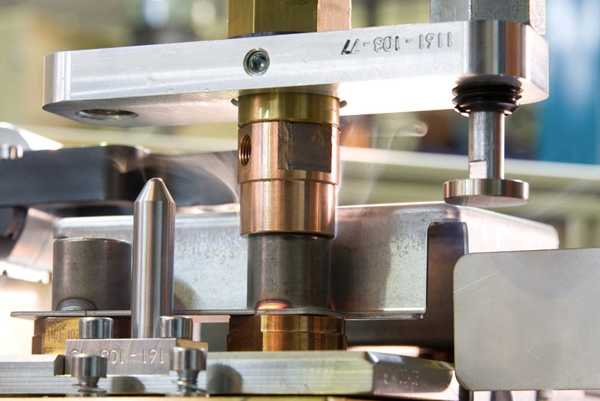MFDC-based short-time resistance welding on press-hardened steels
Challenge: PHS meets short welding times
Press-hardened steels – also known as 22MnB5 or similar grades – have become indispensable in the crash structures of modern vehicles. Their high strength after the hardening process is a true life-saver. But that same strength makes them a real “troublemaker” when it comes to welding.
Traditional resistance stud welding only works to a limited extent, because:
- The surfaces are often coated with aluminium-silicon (AlSi), which affects electrical conductivity.
- The high hardness after press hardening leads to more brittle behavior and a higher risk of cracking.
- Excessive heat input can negatively alter the base material’s properties.
In short: without precise control, every weld becomes a risk zone.
What does medium frequency technology bring to the table?
Medium Frequency Direct Current (MFDC) has long been the standard in resistance welding – and for good reason.
Compared to conventional alternating current (AC) systems, MFDC offers several advantages:
- Precise control of energy input – down to the millisecond
- Steady current flow with minimal fluctuations
- Reduced stray currents – especially beneficial for coated or high-strength materials
- More compact transformers – saving space and reducing energy losses
When it comes to short-time welding – meaning extremely fast current pulses within a few hundred milliseconds – MFDC really shines. It enables targeted heat input that protects the base material while still generating enough plastic deformation in the contact zone – the foundation for a strong and durable joint.
The solution: process know-how and precise control
In a series of test runs, we investigated the welding of nuts onto press-hardened steel sheets (AlSi-coated, 1.5 mm) using MFDC technology. Drawing on our experience with modular welding systems like G-Prime and the targeted use of adaptive welding parameters (force, current, time), we were able to demonstrate:
Yes, it’s possible – with the right setup.
- Customized electrode geometry for optimal current distribution
- Controlled force ramps to protect sensitive surfaces
- Real-time current control enabled by MFDC technology
- Monitoring & analysis tools for 100% traceability
The results were promising:
- Stable weld spots with consistent current/time ratios
- Reproducible mechanical values (torque, tensile shear strength)
- No uncontrolled melting of the AlSi coating
- No hardness drops in the heat-affected zone
What matters most: process parameters must be precisely matched – current level, weld time, electrode geometry, and applied force.
The right combination of technology, expertise, and process monitoring makes all the difference.
What does this mean for production?
For production planners and car engineers, the good news is: yes, short-time resistance welding on press-hardened steel using MFDC can be a process-reliable solution – if done right.
In fact, the method offers several strategic advantages:
- High cycle times are achievable
- Less thermal impact on the base material
- Inline process monitoring is easy to implement
Requirements in car manufacturing are increasing – and we're growing with them. For anyone looking to attach fasteners to press-hardened steel, MFDC short-time welding is definitely worth considering. With proper parameterization and process control, it becomes a robust, efficient solution – ideal for modern vehicle bodies.
And as always: the best results come when material, fastener, and process are considered as one – ideally right from the early development phase.
Do you have specific components or applications that require these kinds of joining processes? Let’s talk. We bring the experience, technology, and flexibility needed to meet your challenges – and turn them into robust solutions.
Contact: post@gatzsch.de
